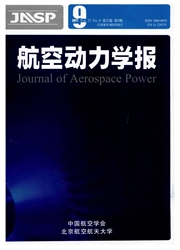

 中文摘要:
中文摘要:
采用STAR-CCM+软件,用经过验证的湍流模型和方法,模拟空间(0~46km)环境中鼻锥模型在超声速飞行状态下的气动热特性,讨论了地面高焓风洞与空间飞行环境的区别.主要区别表现在如下3个方面:1要达到一定的滞止点温度,地面高焓风洞热环境依赖于超声速气动热与电弧加热的耦合作用;2在相同滞止温度的工况下,地面高焓风洞实验使得整个鼻锥实验件壁面都暴露在高温气流下,而空间飞行气动热主要集中在滞止点附近;3在相同滞止温度的工况下,空间飞行器的滞止区压力远远低于地面风洞实验压力.数值模拟揭示:相同来流马赫数下,随海拔高度增加,真实空间飞行条件下鼻锥滞止压力持续降低,而滞止温度则先下降然后升高;在同一空间高度下,随着来流马赫数增大,滞止温度和压力均呈抛物性增长,同时激波位置逐渐靠近前缘壁面,滞止区激波层变薄,但当来流马赫数高于4之后这种趋势将不再明显.
 英文摘要:
英文摘要:
A numerical investigation of the space (0--46 km) aero-thermodynamic char- acteristics of a nose cone model under a state of supersonic flight was performed using com- mercial software STAR-CCM-t- with validated turbulence model and numerical strategy. Then the environment distinctions of the ground high enthalpy wind tunnel and space flight were discussed as follow: (1) To achieve a certain stagnation temperature, the ground high enthalpy wind tunnel environment relies on a coupling effect of supersonic aero-thermody- namics and arc-heating. (2) At the same stagnation temperature condition, a high-tempera- ture flow covers the whole nose cone specimen in the ground high enthalpy wind tunnel case, while in the space flight aero-thermodynamic, a high-temperature area appears just near the stagnation region. (3) At the same stagnation temperature, the stagnation pressure of the space flight is far lower than that in the ground high enthalpy wind tunnel experiment. Nu- merical simulation results indicate that at the same free-stream Mach number, the stagnation temperature goes down at first and then goes up with the increase of flight altitude, while the stagnation pressure drops all the time; at the same altitude, the stagnation temperature and pressure have an exponential increase with the increasing free-stream Maeh number, meanwhile the shock wave moves gradually to the solid wall, and the stagnation region be comes thinner with the increasing free-stream Mach number, but this trend will be not sig nificant when the Mach number is larger than 4.
 同期刊论文项目
同期刊论文项目
 同项目期刊论文
同项目期刊论文
 期刊信息
期刊信息
